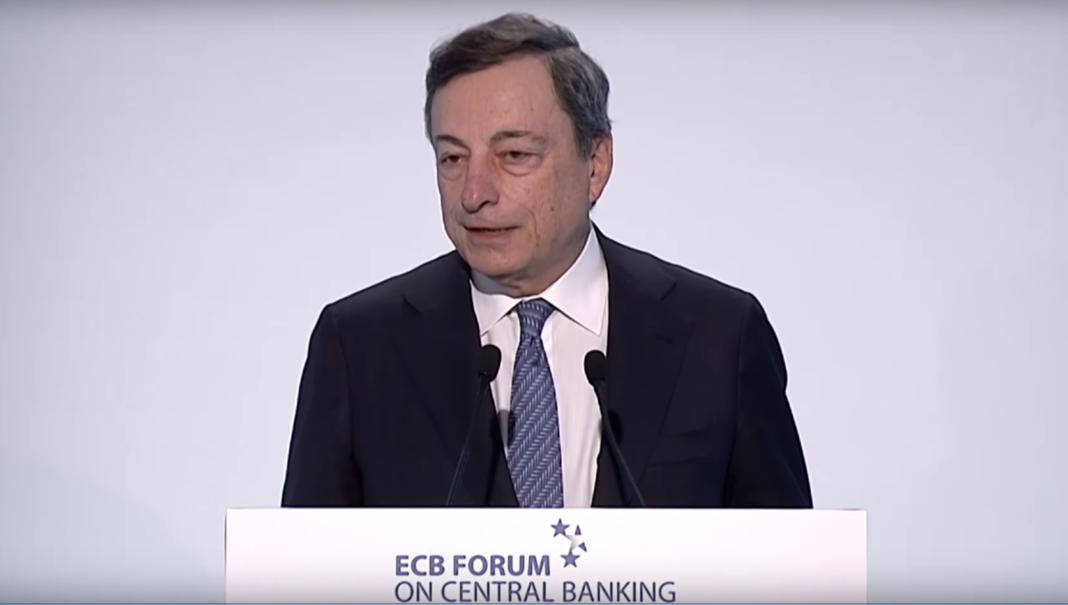最後更新日: 2024年01月23日
歐央行總裁Mario Draghi週二為該行的年度央行研討會的開場演講《
Accompanying the economic recovery 》,令歐元升至今年新高。原因,正是以下一段話:
As the economy continues to recover, a constant policy stance will become more accommodative, and the central bank can accompany the recovery by adjusting the parameters of its policy instruments – not in order to tighten the policy stance, but to keep it broadly unchanged.
市場人士對呢番話的嘅解讀,係Draghi開始支持歐央行收水,例如縮減現行的資產購買計劃。在週三Bloomberg等主要媒體就報道,歐央行的知情人士出面解釋,Draghi的意思並非快將收水,而是希望強調歐央行的貨幣政策「中性」的取態,指出經濟好轉之餘都要繼續保留貨幣寬鬆政策。
本文的重點正正就係上面嗰句以外,Draghi的其他演講內容。
其實在這篇文章中,Draghi要討論的是通脹與整體需求(Aggregate Demand,AD)之間的關係,這當然有兩個層面:貨幣政策對AD的影響,及AD對通脹的影響。
文中,Draghi指出歐央行的寬鬆貨幣政策有效推高AD,例如自2015年開始推行資產購買計劃後歐元區的GDP增長3.6%,而就業人數錄得400萬增長。
Draghi指出,當經濟增長及就業情況轉強,經濟資源將得到更充份的應用,生產資源變得稀少,理應令工資及商品價格上升。歐央行目前的估算是歐元區的Unemployment Gap(即實際失業率與理論中的自然失業率之間的差距)會在未來兩年內消失,而這會為該區在2016至2019年間帶來1.7個百分點的通脹。
The unemployment gap – the difference between actual unemployment and the non-accelerating inflation rate of unemployment (NAIRU) – is narrowing and is forecast by the Commission to close within the next two years. Surveys of business capacity utilisation are now above their long-term average levels. And inflation is recovering. Between 2016 and 2019 we estimate that our monetary policy will have lifted inflation by 1.7 percentage points, cumulatively.
Yet the second leg of the inflation process – the transmission from rising demand to rising inflation – has been more subdued than in the past. How can this be explained?
但這由AD上升引發通脹的情況,近年明顯較預期的更弱,而Draghi就在文中以不少篇幅作討論。
第一個Draghi提出的解釋,是外圍經濟的短期因素(Temporary External Shocks)拖累通脹,一個明顯的例子就正是油價在2014至2015年的急跌。歐央行的研究指,在2015至16年間區內通脹較模型推算的為低,當中約三分二的差距可以用油價相關的因素解釋。
Inflation has indeed been subject to such shocks over recent years, most notably the oil and commodity price collapse in 2014-15. This not only depressed the cost of imported energy, but also lowered global producer prices more generally. ECB analysis suggests that the global component in the underperformance of euro area inflation in recent years was considerable. In 2015-16, around two thirds of the deviation of euro area headline inflation from a model-based mean can be accounted for by global shocks linked to oil prices.
Draghi指,雖然近年油價無再急跌,但早年的油價及商品價格大跌可能有延後效應,而相關的效應在油價無顯著反彈下可能更大,例如油價下跌會令生產時能源需求較高的服務及工業產品的價格下降;這亦令到核心通脹率都無法準確反映通脹的情況。
不過,歐央行的分析認為低油價是源於供應因素,長遠而言若區內的通脹預期不變,這應該不會改變通脹走向。
Global factors therefore do appear to be weighing on the path of inflation today. But our analysis suggests that the drivers of low oil prices at present are mainly supply factors, which a central bank can typically look through.[1] And even if supply factors affect the path of inflation for some time, with inflation expectations secure, they should not ultimately affect the inflation trend.
第二個AD上升亦無法提高通脹的解釋,是歐央行對區內Output Gap的估算不準確,其中一個理由是當AD上升,勞動力供應亦同時上升。Draghi在文中舉列指,自2007年以來美國的勞動參與率(Labour Participation Rate)下降了3個百分點,但歐元區則上升1.5個百分點。
另一方面,就是失業率的未必反映一切。在金融海嘯期間,歐元區的失業率上升同時,就業不足及臨時工人亦同時上升,Draghi認為這對通脹的走勢有影響,因為這類只有工時不足的僱員在商討新職業安排時,可能會傾向要求更多工時多於更高薪酬。
Another reason why there is some uncertainty over slack is the correct notion of unemployment – that is, there may be residual slack in the labour market that is not being fully captured in the headline unemployment measures. Unemployment in the euro area has risen during the crisis, but so too has the number of workers who are underemployed (meaning that they would like to work more hours) or who have temporary jobs and want permanent ones. This has implications for inflation dynamics, since these people might prioritise more hours or job security over higher wages in employment negotiations.
他又指出,如果計及就業不足及邊際勞動力,亦即是所謂的U6失業率計,失業率高達18%。該行的研究又指,以U6來推算的Phillips Curve預測力更強。
另一個Draghi提及的可能解釋是近年的定價行為改變,可能令薪酬及價格上升的速度減慢,例如近年區內推行動市場改革,令公司層面的集體談判(Firm-level wage bargaining) 制度更普及,這可能令薪酬下降的靈活性較上升的更大;亦可能因為企業認為前景不穩,可能會寧願減低毛利率來應對成本上升;這些都令通脹升幅較預期低。
第三個AD無法令通脹上升的解釋,是低通脹變得更頑固。例如歐央行的研究指,低通脹就令2014年至16年的薪酬增長低0.25個百分點,成因可能是薪酬制定機制與以往的通脹掛鉤,令低通脹低工資增長的變得較頑固。
That being said, a prolonged period of low inflation is always likely to be exacerbated by backward-lookingness in wage and price formation that occurs due to institutional factors, such as wage indexation.
This has plainly happened in the euro area. ECB analysis finds that, compared with long-term averages, low past inflation dragged down wage growth by around 0.25 percentage points each year between 2014 and 2016.
值得留意是,Draghi認為上述三大因素(外圍因素、勞動供應彈性較預期高、低通脹較頑固)都是短期的情況,並相信會慢慢減退。
在演講尾段,Draghi指明白到長期的衰退環境可能引發大量後遺症(亦即所謂的Hysteresis),令實體經濟長期增長力下降,這亦是該行早年要果段行動的原因。現在他有信心這些刺激政策有效,但現階段仍要持續刺激政策,令通脹可持續增長。
Nevertheless, we are still in a situation of continuing slack, and where a long period of subpar inflation translates into a slower return of inflation to our objective. Inflation dynamics are not yet durable and self-sustaining. So our monetary policy needs to be persistent.
本網內容全數由Patreon嘅讀者贊助
如果你都鐘意我地嘅文章,可以考慮成為我地最新嘅Sponsor !
想睇到我地最新嘅文章,可以去Telegram follow 我地 詳見《Econ記者使用說明》







